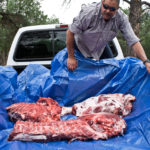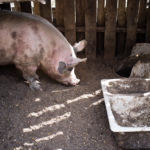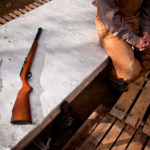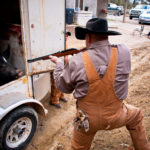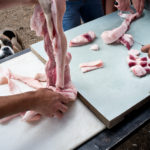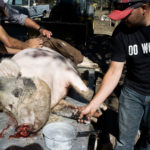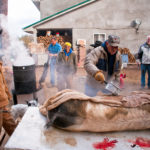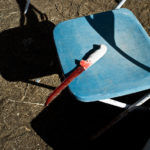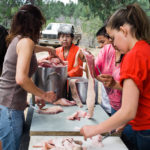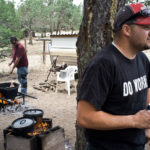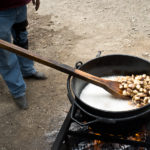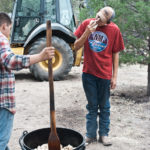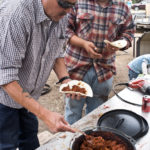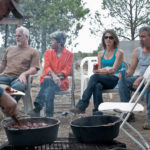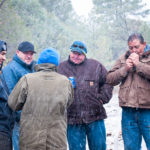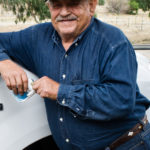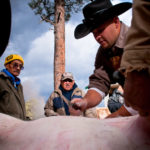Tradición: Matanza
“That is hard to watch”, Victor Mora says as eight men struggle to move the pig’s body to the prep table.
“I raised her from a baby”, he continues, “fed her corn every day.” He shakes his head and sucks in a breath. “That is hard to watch…”, he says again. There is a note of gentle resignation in his voice – the kind that comes to people accustomed to the harder realities in life. He looks up at the men and then down at his feet and shakes his head again.
His grandsons – James and Eloy – have just killed his pig, a sizable animal weighing several hundred pounds. James shot it in the forehead with a .22 rifle and Eloy then used a white handled knife to stop its heart quickly. It was a violent few minutes marking the beginning of the matanza.
A Matanza, from the Spanish verb “Matar” (to kill), is the slaughter and butchering of a food animal, often a goat or a pig. In New Mexico the tradition dates back to Spanish colonial times where the butcher of an animal fed entire villages – often groups of extended family members – and gave opportunities for family gatherings, festivals, and celebrations of important events.
Each family has its own style; some create all night festivals with the pig cooked in a pit; others are more utilitarian and focus on the butchering and preservation of the meat. The Moras of the Manzano Mountains in central New Mexico do a bit of both and are butchering the sow because they have to. She is big and food for the family is needed. The younger generations take the opportunity to leave the city and return to the family ranch lands – to connect with their roots. Five generations are present to help in all aspects of the processing.
Today there is a full day’s worth of work to do. The older men teaching Eloy and James have held Matanzas most of their lives and supervise, occasionally stepping in to guide, give advice, or lend muscle, their speech flipping swiftly between Spanish and English. The family speaks in the easy way of people that know each other well. Now and again various extended family members- primos, tios, abuelos – arrive, watch, and help. All agree this pig is large; there will be meat for empanadas, carnitas, ribs, carne adovada, and everyone’s favorite: chicharrones.
James explains why he and Eloy are leading this matanza: “I’ve been to matanzas all my life. Not everyone does them anymore and this is part of our tradition, our culture. My grandfather is getting old and my father will be one day too. It is for us to carry on. This is important to us and we need to learn how to do it while my grandfather is still alive. I mean, if you don’t have your traditions, your family, how do you know who you are?”
From early in the morning until late in the afternoon the family works at butchering the pig, cooking in large cast iron pots, prepping the meat, eating and laughing. Whether it rains, snows, or the sun shines, once the Matanza begins it must continue to the end. On one occasion we stand in ankle deep sucking mud brought on by the first winter snows. On another the work is done in short sleeve shirts.
Near the end of the day, as the shadows begin to lengthen, Victor leans over and stirs a pot of stewing carne adovada poised over a wood fire, the deep red of the chile sauce blends with the pork. “Most people have no idea where their food comes from,” he says. “Me? I know.”
He gazes across the side yard of his desert mountain home at his family and a smile creases his weathered face.
These images were photographed during two separate matanzas at the Mora’s. One in the fall of 2012 during the first snow of the winter. The other on a warm Spring day, 2013.


